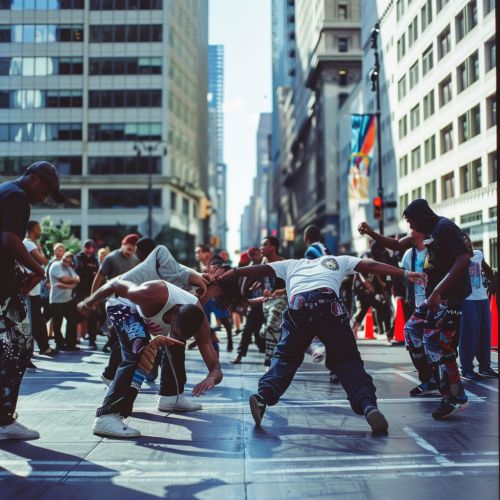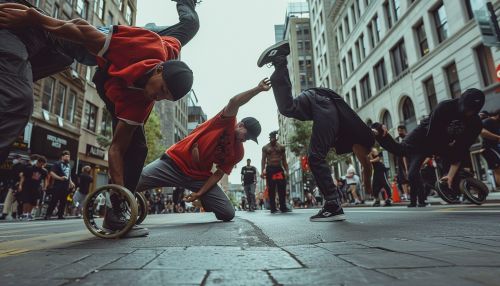Hip-Hop
Origins and Evolution of Hip-Hop
Hip-hop is a cultural movement that emerged in the early 1970s in the Bronx, New York City. It encompasses a variety of artistic forms, including rapping, DJing, breakdancing, and graffiti art. The movement was born out of the socio-economic struggles faced by African American and Latino youth in urban environments. Hip-hop provided a voice and a means of expression for these communities, addressing issues such as poverty, violence, and racial discrimination.
Early Influences
The roots of hip-hop can be traced back to several musical genres and cultural practices. Funk, soul, and disco were significant influences, as were the spoken word traditions of African American poets and the toasting practices of Jamaican DJs. The block parties held in the Bronx during the 1970s played a crucial role in the development of hip-hop, as DJs like DJ Kool Herc began to experiment with breakbeats and turntablism.
The Four Pillars
Hip-hop is often described as having four main elements or "pillars":
- Rapping: Also known as MCing, rapping involves the rhythmic delivery of rhymes and wordplay over a beat. It is a form of vocal expression that combines poetry and music.
- DJing: DJs use turntables and mixers to create music by manipulating records. Techniques such as scratching, beatmatching, and sampling are fundamental to DJing.
- Breakdancing: Also known as b-boying, breakdancing is a style of street dance that includes acrobatic moves, footwork, and freezes. It is often performed to the breakbeats created by DJs.
- Graffiti Art: Graffiti involves the use of spray paint to create visual art on public surfaces. It is a form of self-expression and a way to claim space in urban environments.
The Golden Age of Hip-Hop
The late 1980s and early 1990s are often referred to as the "Golden Age" of hip-hop. During this period, the genre experienced significant growth and diversification. Artists began to experiment with different styles and themes, leading to the emergence of subgenres such as gangsta rap, conscious rap, and alternative hip-hop.
Notable Artists and Albums
Several artists and albums from the Golden Age have had a lasting impact on hip-hop culture:
- Public Enemy: Known for their politically charged lyrics and innovative production, Public Enemy released seminal albums such as "It Takes a Nation of Millions to Hold Us Back" (1988) and "Fear of a Black Planet" (1990).
- N.W.A: As pioneers of gangsta rap, N.W.A brought attention to the realities of life in South Central Los Angeles with their controversial album "Straight Outta Compton" (1988).
- A Tribe Called Quest: This group is known for their jazz-influenced sound and socially conscious lyrics. Their album "The Low End Theory" (1991) is considered a classic.
- De La Soul: With their eclectic sampling and playful lyrics, De La Soul's debut album "3 Feet High and Rising" (1989) helped to define the alternative hip-hop movement.
Commercialization and Mainstream Success
By the mid-1990s, hip-hop had become a dominant force in the music industry. Artists such as Tupac Shakur, The Notorious B.I.G., Jay-Z, and Nas achieved mainstream success and brought hip-hop to a wider audience. The genre's commercial appeal led to the rise of major record labels and the proliferation of hip-hop media, including magazines, television shows, and radio stations.
Regional Scenes
As hip-hop spread across the United States, distinct regional scenes emerged, each with its own unique sound and style:
- West Coast: Characterized by the G-funk sound, West Coast hip-hop was popularized by artists such as Dr. Dre, Snoop Dogg, and Ice Cube.
- East Coast: Known for its gritty, street-oriented sound, East Coast hip-hop was dominated by artists like Wu-Tang Clan, Nas, and The Notorious B.I.G..
- Southern Hip-Hop: The South developed its own style, with subgenres such as crunk, trap, and bounce. Notable artists include OutKast, Lil Wayne, and T.I..


Contemporary Hip-Hop
In the 21st century, hip-hop continues to evolve and diversify. The genre has become a global phenomenon, influencing music, fashion, language, and culture around the world. Contemporary hip-hop artists experiment with a wide range of sounds and themes, reflecting the changing landscape of society.
Subgenres and Innovations
Several subgenres and innovations have emerged in contemporary hip-hop:
- Trap: Originating in the Southern United States, trap music is characterized by its heavy use of 808 drum machines, rapid hi-hats, and dark, moody lyrics. Artists such as Future, Migos, and Travis Scott have popularized this style.
- Mumble Rap: Known for its emphasis on melody and vocal delivery rather than lyrical complexity, mumble rap has been both celebrated and criticized. Notable artists include Lil Uzi Vert, Playboi Carti, and Lil Yachty.
- Experimental Hip-Hop: Artists in this subgenre push the boundaries of traditional hip-hop by incorporating elements from other genres, such as electronic music, rock, and jazz. Kanye West, Tyler, The Creator, and Death Grips are known for their experimental approach.
Global Influence
Hip-hop's influence extends beyond the United States, with vibrant scenes in countries such as France, the United Kingdom, South Korea, and Brazil. International artists bring their own cultural perspectives to the genre, creating unique blends of hip-hop and local music traditions.
Social and Cultural Impact
Hip-hop has had a profound impact on society and culture. It has provided a platform for marginalized communities to express their experiences and advocate for social change. The genre has also influenced language, fashion, and art, shaping popular culture in significant ways.
Activism and Advocacy
Many hip-hop artists use their platform to address social and political issues. From Public Enemy's critiques of systemic racism to Kendrick Lamar's reflections on police brutality and inequality, hip-hop has been a powerful tool for activism and advocacy.
Fashion and Style
Hip-hop fashion has evolved over the decades, from the b-boy style of the 1980s to the luxury streetwear of today. Brands such as Adidas, Nike, and Supreme have become synonymous with hip-hop culture, and artists often set trends with their distinctive styles.
Language and Slang
Hip-hop has contributed significantly to the evolution of language and slang. Terms and phrases coined by hip-hop artists often enter mainstream usage, reflecting the genre's influence on everyday speech.
